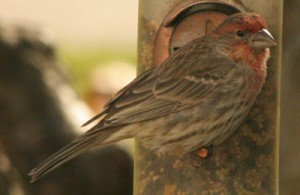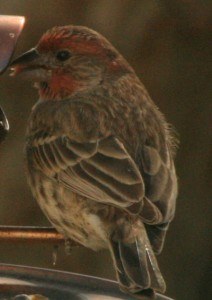House Finch
General:
The House Finch was originally an inhabitant to the west coast of the U.S. and Mexico but has been introduced to the east coast. According to Audubon, in the 1940’s caged House Finches were released in New York City and Long Island, New York. Since that time, the House Finch has established new territory along the Atlantic coast. House Finches were introduced to Oahu from San Francisco sometime before 1870. They had become abundant on all the major Hawaiian Islands by 1901. As with all such events, unintended consequences have occurred. Competition for food and habitat resulted in East coast populations of native Purple Finch and the invasive House Sparrow to decline. (1)
 With its increased territory and adaptability, the total House Finch population across North America is estimated between 267 million and 1.4 billion individuals. (2)
With its increased territory and adaptability, the total House Finch population across North America is estimated between 267 million and 1.4 billion individuals. (2)
House Finches nest in many different places from man-made structures to trees to rock ledges. They will use abandoned nests of other birds. Overall width of the nest is 3-7 inches, with the inside cup 1-3 inches across and up to 2 inches deep.
 The female lays 2 to 6 pale blue to white eggs speckled with fine black and pale purple markings. The eggs are about .6” long and ½” wide. The chicks hatch in 13 to 14 days and are naked except for sparse white down along feather tracts. They fledge in 12 to 19 days.
The female lays 2 to 6 pale blue to white eggs speckled with fine black and pale purple markings. The eggs are about .6” long and ½” wide. The chicks hatch in 13 to 14 days and are naked except for sparse white down along feather tracts. They fledge in 12 to 19 days.
House Finches can have two or more broods per year.
In captivity House Finches have lived as long as 11 years.
Identification:
House Finches are about the same size as House Sparrows but more slender. They measure 5.1” – 5.5” long and with a wingspan between 7.9” – 9.8”. They weigh ½ oz – 1 oz.
Adult males are rosy red around the face and upper breast, with streaky brown back, belly and tail. Adult females are plain grayish-brown with thick, blurry streaks and an indistinctly marked face.
The red of a male House Finch comes from pigments contained in its food. Because of this, sometimes orange or yellowish male House Finches will be observed.
Habitat:
House Finches inhabit city parks, backyards, urban centers, farms, and forest edges across the continent. In the western U.S., House Finches native habitat is desert, grassland and open woods. They are frequent late fall and winter visitors to my upstate NY backyard birdfeeder.
Territory:
Native range was west coast from Mexico to Canada east to Texas and Nebraska. The east coast population is north to Maine and Canada south to Florida and west to the Mississippi. (3)
Migration:
These birds are mainly permanent residents; some eastern birds migrate south.
Diet:
House Finches eat almost exclusively plant materials, seeds, buds and fruits. In orchards, House Finches eat cherries, apricots, peaches, pears, plums, strawberries, blackberries, and figs.
1. Wootton, JT. (1987). “Interspecific Competition between Introduced House Finch Populations and Two Associated Passerine Species”. pages 325–331.
3. Belthoff, James R.; Gauthreaux, Sidney A. (1991). “Partial Migration and Differential Winter Distribution of House Finches in the Eastern United States”